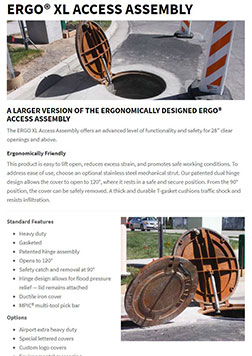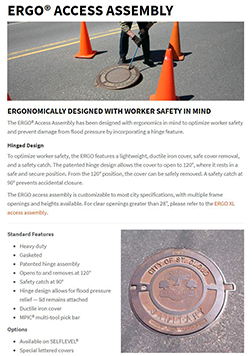Engineered Products Promote Worker Safety
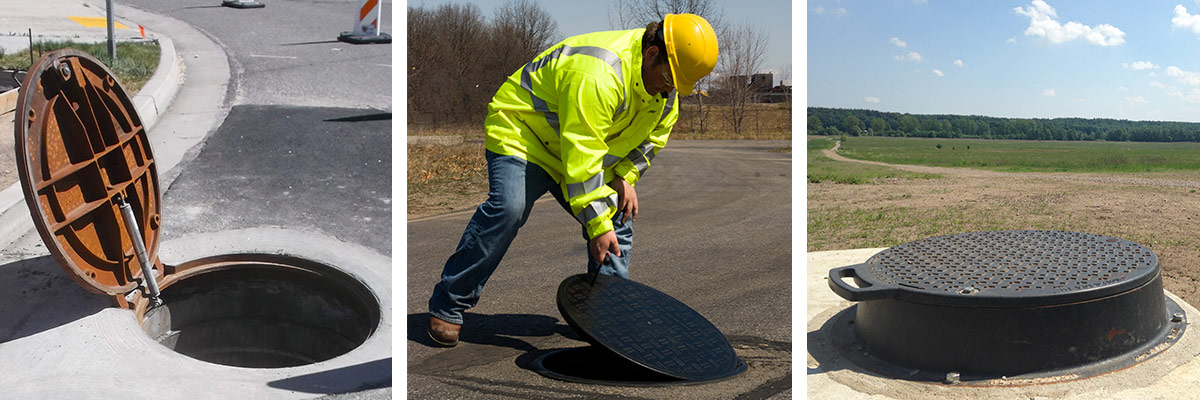
New Solutions Meet Modern Infrastructure Challenges
New Technologies Deliver Safety and Cost Benefits
La información se presenta en Inglés. Una vez traducida, está se actualizará.
For municipal professionals who treat, deliver, and protect public water services, the essentials remain the same: Operations must be maintained 24/7. The public must be protected from infrastructure hazards such as gas build up, stray voltage, and odor, and facilities must be protected from unauthorized access. Modern infrastructure access technologies offer solutions to protect communities in an economically viable way.
Two areas of real-world innovations offer new solutions for meeting these infrastructure challenges: innovative designs for covers and hatches, and new materials offering advantages in weight and environmental resistance. While no single product provides the “silver bullet” solution for all environments, those who maintain water resources now have a more comprehensive offering to choose from.
Engineered Ergonomic Designs Make it Easier and Safer to Access Your Infrastructure
Traditionally, removing a manhole cover requires a great deal of force that can affect the shoulders, knees, and back. Replacing the cover may require even more force. OSHA records describe lacerations and broken bones resulting from a team’s uncoordinated lifting and moving of these heavy objects. Hinged covers with optional lift-assist devices significantly reduce the force workers must generate. With a lift-assist cover, even a 600-pound lid (the largest hatch cover by EJ) requires only 35 pounds of lifting force.
This ease also negates the need for a crane or other lifting machinery. These mechanisms bring further advantages as well:
- Smaller teams are required to access secured systems.
- With reduced lifting requirements, more team members can perform services.
Hinged covers and lids can be designed to help address another safety issue: premature closure. OSHA records describe grave injuries resulting from a team member losing grip or dropping a cover from fatigue. Modern casting designs include a safety catch to prevent accidental closure.

The Detroit Water and Sewerage Department installs only ergonomic varieties when they replace frames and covers for their standard 24-inch access points. “The department was open to working smarter rather than harder,” James Cassel, a Technical Sales Engineer at EJ, summarized. According to Cassel, driving the department’s decision was the reality of having fewer people to do the same work. Detroit Water and Sewerage Department has also adopted hinged grates for its catch basins, which eliminated having to climb down into the catch basin to retrieve a fallen grate.
REVOLUTION Access Assembly
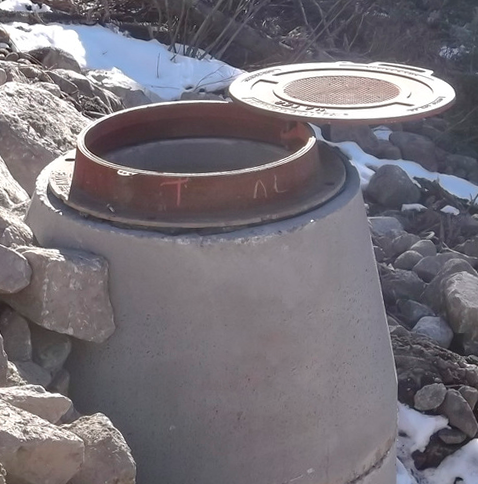 For elevated structures and raised access points, the solution may be rotation rather than lifting removal. To avoid the safety issues created by removing a cover at height and lowering it to the ground, EJ has developed a system that allows the cover to pivot away from the access hole while it remains joined to its frame. The cover rotates on a stainless-steel rod. This helps avoid the unsafe practice of balancing the removed cover on the edge of its frame, where it might fall and cause serious injury. Because rotating the cover requires no lifting, only one worker is required to open the access point. The assembly may include a lightweight cover, a neoprene gasket to control odors, a water-resistant cover that overlaps its frame, an integrated hole for padlocks, and bolting options to secure the cover to its frame.
For elevated structures and raised access points, the solution may be rotation rather than lifting removal. To avoid the safety issues created by removing a cover at height and lowering it to the ground, EJ has developed a system that allows the cover to pivot away from the access hole while it remains joined to its frame. The cover rotates on a stainless-steel rod. This helps avoid the unsafe practice of balancing the removed cover on the edge of its frame, where it might fall and cause serious injury. Because rotating the cover requires no lifting, only one worker is required to open the access point. The assembly may include a lightweight cover, a neoprene gasket to control odors, a water-resistant cover that overlaps its frame, an integrated hole for padlocks, and bolting options to secure the cover to its frame.
Manufacturing, Engineering, and Material Improvements
Years ago, when iron quality and molding techniques were less consistent, castings (such as manhole covers, frames, and hatches) were overbuilt to account for a margin of error. Today, modern manufacturing processes and better engineered designs create products requiring less raw material. Modern cast products feature the ability to handle heavy load ratings (exceeding AASHTO M 306 proof load testing), greater strength, and reduced weight—always an ergonomic benefit.
From this ability to more tightly control gray iron castings, ductile iron evolved. A form of cast iron, ductile iron features higher tensile strength and less weight than comparable gray iron (the most popular form of cast iron). Because its manufacture must be tightly controlled, ductile iron costs a bit more than gray iron, yet its strength allows the creation of thinner covers, hatches, and frames.
Composites Offer Exceptional Solutions in Challenging Environments.
A newer material class, composites, has started to make headway into the niche traditionally held by iron castings. “Composites” address the need for strong-but-lighter products in an entirely different way. While composites are not new the acceptance of high-performance composite materials has been slower in the United States than in Europe. Although their most obvious advantage is their lightness when compared to iron and steel covers, today’s new high-performance composite materials can be engineered to meet a variety of critical needs in cities and facilities.
By tailoring the combination of the resin matrix and reinforcement materials, engineers adapt covers to survive challenging environments. It’s similar to varying the components in a cement mix to create different characteristics in concrete. Consequently, composites have found a home in a variety of industries.
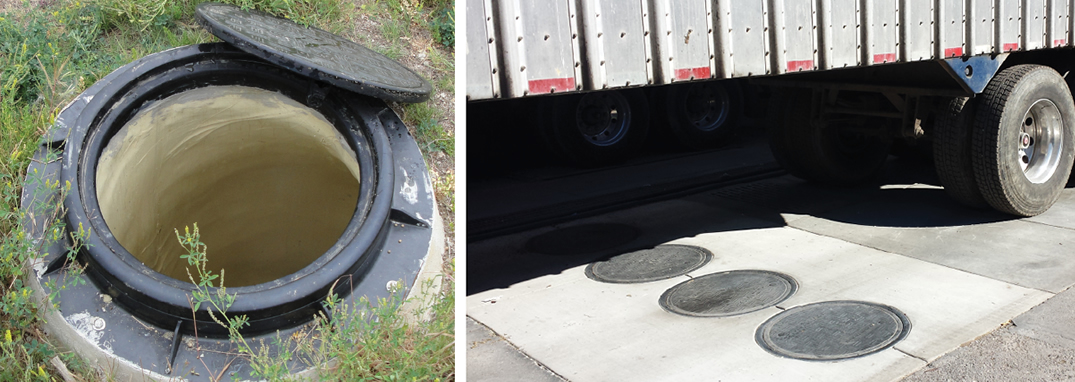
In one scenario, a city might prefer a composite manhole cover capable of bearing the weight of 18-wheelers, as mandated by AASHTO M306 HS-20. In fact, a large West Coast public utility has recently begun replacing its traditional manhole covers with composites. A large electrical utility on the East Coast specified composite manhole covers for a range of reasons, deciding the total cost of ownership of composite covers justified the greater initial cost. For that utility—facing decaying electrical infrastructure—containing stray electrical current transfer was a primary concern; consequently, it was attracted to composite covers’ non-conductive characteristic. At the same time—because it prefers covers without locking mechanisms—the East Coast utility wanted the covers to be heavy. It chose a combination of iron and composite materials to create a hybrid solution.
Composite covers are crafted to be non-reactive to their environment. They offer advantages in guarding access to sewers and protection from the frequent presence of hydrogen sulfide. In steam plants, for example, they are useful because they can be manufactured to conduct little heat. These innate characteristics of composites offer one way to address the significant cost of repairing and replacing sewer infrastructure components.
Composites offer another advantage over their iron cousins: Composites generally have no scrap value. This characteristic reduces the chance that the cover will be stolen. Moreover, it also reduces the risk that a thief will leave an open manhole behind, creating a secondary safety and political issue.
But perhaps the greatest advantage of composites is the ease with which they can be handled by workers. One manufacturer’s representative noted that, “If you think along the lines of safety, you see the necessity to design products that suit the workers and that are proven to be safer.”
In this sense, composites share an advantage with lift-assisted covers and lids: Their ergonomic design increases worker safety. As plant managers know, worker safety translates to reduced operational costs.
Total Cost of Ownership
Manhole frames and covers utilizing innovative materials, ergonomics, and lift-assist mechanisms may require a greater initial investment than traditional products. However, these innovations offset that cost by helping to solve problems that managers have faced for years: the often time-consuming, and sometimes dangerous, methods of accessing areas that must be periodically serviced.
When clients ask whether an innovative product would be worthwhile, EJ advises clients to weigh the cost of worker injuries. EJ stresses that ergonomic devices reduce the possibility of having injured workers, lost work hours, and workman compensation claims. Optimized design, modern manufacturing, material choice, and ergonomics all combine to create products that protect critical public infrastructure and promote safer environments for the workers that handle them.
Learn More
Talk to an expert to find out how the innovative solutions by EJ can work for your next project.
